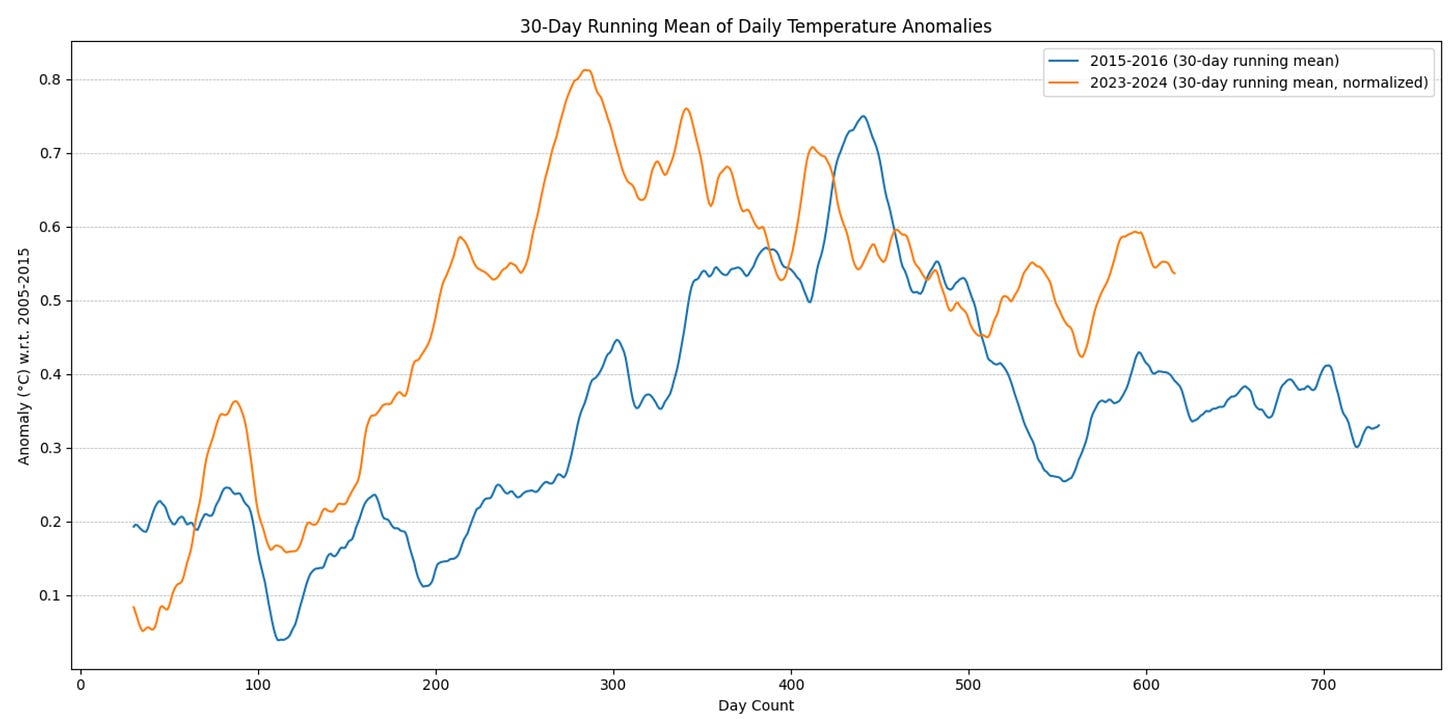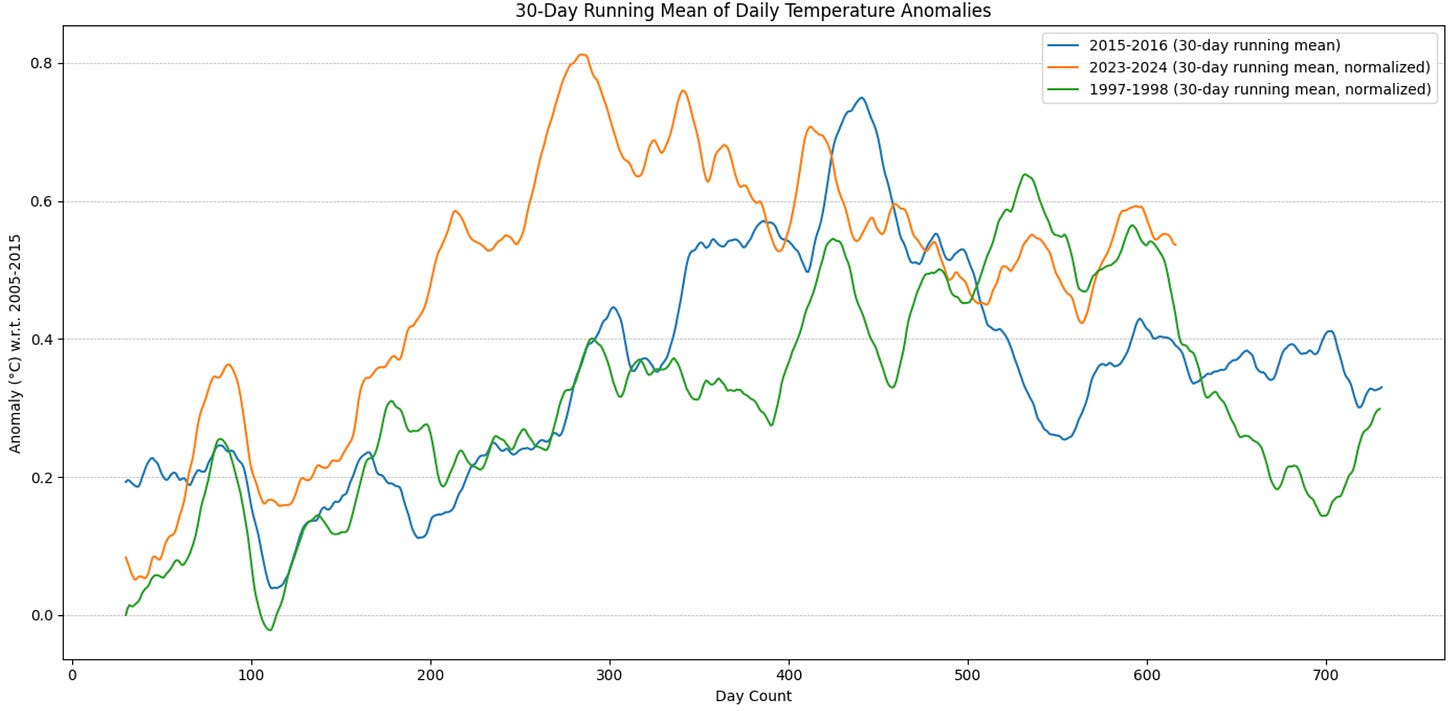2024’s unusually persistent warmth
Posted on 16 September 2024 by Zeke Hausfather
This is a re-post from The Climate Brink
My inaugural post on The Climate Brink 18 months ago looked at the year 2024, and found that it was likely to be the warmest year on record on the back of a (than forecast) El Nino event. I suggested “there is a real chance that the world exceeds 1.5C above preindustrial levels in 2024 in the Berkeley Earth record” but that “it is still more likely than not that 2024 temperatures come in below that level.”
Since that post, I think its safe to say that the intervening year and a half surprised us all. We saw extreme (one might even say gobsmacking) global surface temperatures in the second half of 2023, which pushed the year above 1.5C in the Berkeley Earth record (and just shy of 1.5C in Copernicus). This heat arrived far earlier than any of us anticipated; even before the El Nino event that we expected to drive record warmth had fully developed. Global temperature records were shattered by between 0.3C and 0.5C in each month from July to December 2023.
In early 2024 it appeared as if the world had potentially returned to a more predictable (though far from good!) regime, with global temperature records exceeding the prior records set in the winter of 2016 by around 0.1C, which is reasonably in-line with what we would expect to see for a big El Nino event 8 years after the 2016 super El Nino.
At the time I (and others) suggested that global temperatures would likely begin to fall back down to around 1.3C above preindustrial levels by June, and end up well below 2023 for the second half of the year as El Nino faded and La Nina conditions potentially developed. This seemed like a reasonable expectation based on the trajectory of prior El Nino events (e.g. 2016). However, nature had something else in mind:
Monthly global surface temperature anomalies from Copernicus/ECMWF’s ERA5 reanalysis product, with 2023 and 2024 highlighted. An estimate and uncertainty range is provided for September 2024 based on the first week of the month.
Rather than falling out of record territories, global temperatures have remained highly elevated going into the summer and fall months. We saw new temperature records in May and June, and tied the exceptional heat of 2023 in July and August. Its only in September – which shattered prior records by 0.5C in 2023 – that we will very likely see global temperatures falling out of record territory.
Climate scientists tend to assume that, unless there is compelling reasons to expect otherwise, past climate behavior provides a reasonably good analogue to what we expect to see in the future.
To that end, the last big El Nino event (which developed in 2015 and peaked in early 2016) provides a useful point of comparison with what has happened over the past 18 months.
The figure below shows the evolution of global temperatures for both the 2015-2016 period (in blue) and the 2023-2024 period (in orange). A 30-day running mean of temperatures is shown to minimize noise from daily variability in global temperatures, and the x-axis shows a count of days since the start of the period (e.g. 2015 and 2023, respectively). The 2023-2024 temperatures are further normalized by subtracting 0.16C, which is an approximation of the amount of human-driven warming we expect between 2015/2016 and 2023/2024.

A 30-day average of global surface temperature anomalies from Copernicus/ECMWF ERA5 for the 2015/2016 and 2023/2024 periods.
Here two factors stand out. First, the heat arrived much earlier in 2023 than it did in 2015. In 2015, global temperatures only began to be significantly elevated in the last two months of the year (e.g. November and December). By contrast, 2023 saw a rapid increase in temperatures starting in June. Similarly, the 2015/2016 El Nino saw a peak in global temperature response in March 2016, while the 2023/2024 event saw a peak in September 2023.
Finally, in 2016 global temperatures began to fall in mid-May as the El Nino event faded. By contrast, 2024 temperatures have remained elevated through early September (so far) rather than declining.
We can also include the prior big El Nino event – 1997/1998 – in the figure below. That El Nino event did see more persistent heat than 2015/2016, with temperatures remaining elevated until the start of September 1998, after which point they rapidly declined.

Same as above, but including 1997/1998.
While its possible that global temperatures will finally start to fall in the next few weeks, given the highly anomalous trajectory of 2023 and 2024 to-date I would not bet on it.
Unfortunately we still lack a good explanation for what drove the exceptional warmth the world saw in 2023 and 2024. We have a lot of potential mediocre explanations (e.g. low sulfur marine fuel regulations, the Hunga Tonga volcanic eruption in 2022, an uptick in the 11 year solar cycle, El Nino behaving weirdly, etc.). But these have increasingly been modeled, and it is hard to explain the magnitude of the global temperature anomaly the world has experienced even adding all of these estimates together.
Many of us hoped that if 2024 returned to a more predictable post-El-Nino regime it would provide evidence that what happened in the second half of 2023 was a blip – some short lived internal variability that drove a spike in global temperatures but did not persist.
However, with temperatures remaining elevated into September 2024, its looking increasingly less likely that last year’s elevated temperatures were a mostly transient phenomenon. Rather, some combination of forcings or changes in feedbacks may be driving higher global temperatures going forward.
